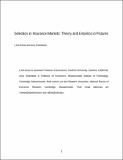| dc.contributor.author | Einav, Liran | |
| dc.contributor.author | Finkelstein, Amy | |
| dc.date.accessioned | 2011-02-28T13:35:08Z | |
| dc.date.available | 2011-02-28T13:35:08Z | |
| dc.date.issued | 2011 | |
| dc.identifier.issn | 0895-3309 | |
| dc.identifier.uri | http://hdl.handle.net/1721.1/61349 | |
| dc.description.abstract | Government intervention in insurance markets is ubiquitous and the theoretical basis for such intervention, based on classic work from the 1970s, has been the problem of adverse selection. Over the last decade, empirical work on selection in insurance markets has gained considerable momentum. This research finds that adverse selection exists in some insurance markets but not in others. And it has uncovered examples of markets that exhibit "advantageous selection"—a phenomenon not considered by the original theory, and one that has different consequences for equilibrium insurance allocation and optimal public policy than the classical case of adverse selection. Advantageous selection arises when the individuals who are willing to pay the most for insurance are those who are the most risk averse (and so have the lowest expected cost). Indeed, it is natural to think that in many instances individuals who value insurance more may also take action to lower their expected costs: drive more carefully, invest in preventive health care, and so on. Researchers have taken steps toward estimating the welfare consequences of detected selection and of potential public policy interventions. In this essay, we present a graphical framework for analyzing both theoretical and empirical work on selection in insurance markets. This graphical approach provides both a useful and intuitive depiction of the basic theory of selection and its implications for welfare and public policy, as well as a lens through which one can understand the ideas and limitations of existing empirical work on this topic. | en_US |
| dc.language.iso | en_US | |
| dc.publisher | American Economic Association | en_US |
| dc.relation.isversionof | http://dx.doi.org/10.1257/jep.25.1.115 | en_US |
| dc.rights | Creative Commons Attribution-Noncommercial-Share Alike 3.0 | en_US |
| dc.rights.uri | http://creativecommons.org/licenses/by-nc-sa/3.0/ | en_US |
| dc.source | MIT web domain | en_US |
| dc.title | Selection in Insurance Markets: Theory and Empirics in Pictures | en_US |
| dc.type | Article | en_US |
| dc.identifier.citation | Einav, Liran, and Amy Finkelstein. 2011. "Selection in Insurance Markets: Theory and Empirics in Pictures." Journal of Economic Perspectives, 25(1): 115–38. | en_US |
| dc.contributor.department | Massachusetts Institute of Technology. Department of Economics | en_US |
| dc.contributor.approver | Finkelstein, Amy | |
| dc.contributor.mitauthor | Finkelstein, Amy | |
| dc.relation.journal | Journal of Economic Perspectives | en_US |
| dc.eprint.version | Final published version | en_US |
| dc.type.uri | http://purl.org/eprint/type/JournalArticle | en_US |
| eprint.status | http://purl.org/eprint/status/PeerReviewed | en_US |
| dspace.orderedauthors | Einav, Liran; Finkelstein, Amy | en |
| dc.identifier.orcid | https://orcid.org/0000-0002-9941-6684 | |
| mit.license | OPEN_ACCESS_POLICY | en_US |
| mit.metadata.status | Complete | |
